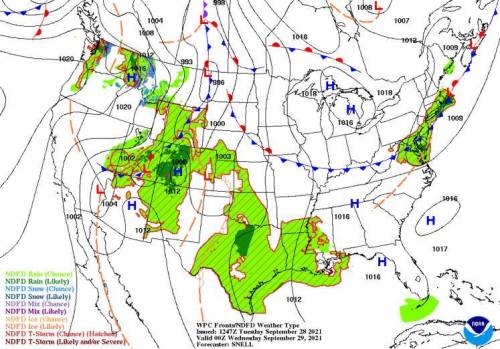
Biology, 06.10.2021 06:30, codyshs160
1. What does the “H” on the map represent?
2. What kind of weather is usually found in areas with high pressure?
3.According to the map, what kind of weather will we have on Wednesday? Explain.
4. What kind of weather is predicted for the Northern Great Lakes Region of the country? Explain.
5. What does the “L” on the map represent?
6. What kind of weather is usually associated with areas of low pressure?
7. What do the curved lines with blue triangles represent? Explain.
8. What do the curved lines with red half-circles represent? Explain.
9. What do the lines with both, blue triangles, and red half-circles, represent? Explain.
10. Based on the map, what kind of weather is expected for most of Texas and Louisiana?
11. What date is the map predicting the weather for?


Answers: 2
Other questions on the subject: Biology

Biology, 22.06.2019 04:00, paigefields2578
The wings of insects, birds, and bats evolved independently but carry out similar functions. this is an example of a. analogous structures. b. embryonic structures. c. vestigial structures. d. homologous structures.
Answers: 1

Biology, 22.06.2019 04:00, juan01sebastian00
Aflame cell is at the end of each tubule of the nephridium malpighian tubules kidneys none of the above
Answers: 1

Biology, 22.06.2019 08:10, xojade
Ascience research group is testing a new type of plant food. one trial is conducted in a controlled experiment. the data from the trial show that the plant that received the new food grew faster than the control plant. the group announces that the new plant food makes plants grow faster. what is the main weakness in this scientific claim?
Answers: 2

Biology, 22.06.2019 09:40, GreatBaconGamer
For the strategies below, decide whether they are best described as demand-side solutions or supply-side solutions to meeting human needs for fresh water. remember that a demand-side solution reduces demand for fresh water, whereas a supply-side solution increases the supply of fresh water. (a) damming a river to create a reservoir (b) desalinating seawater (c) a nation invading a neighboring country to access their rivers (d) raising water prices for consumers and businesses (e) providing tax breaks for companies that use less water (f) replacing inefficient irrigation with more-efficient drip irrigation to grow crops (g) requiring low-flow showerheads in all new homes
Answers: 1
Do you know the correct answer?
1. What does the “H” on the map represent?
2. What kind of weather is usually found in areas with...
Questions in other subjects:

English, 06.11.2020 17:30



Mathematics, 06.11.2020 17:30


Mathematics, 06.11.2020 17:30

English, 06.11.2020 17:30








